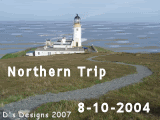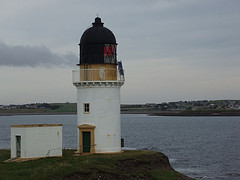During the Napoleonic wars, the privately owned estates in northwestern Scotland provided seaweed for the production of gunpowder. Strangely enough, if you dry and burn seaweed you're left with potassium nitrate, a component of explosives. The normal source of nitrate, bird droppings scraped from rocks in South America, was unavailable because the UK was blockaded by French warships. Thousands of people lived in coastal settlements, harvesting kelp. When war ceased in 1815, all those people were without income. The price of kelp had nosedived once demand fell away.
The estate owners were now lumbered with large numbers of people who could not afford the rents, and keeping sheep for wool presented itself as a tidy money spinner, requiring a minimal capital investment for a decent return. So, the people had to go. In some instances, the rents were increased manyfold, giving the landlords a pretext for forced eviction. In other instances, they served whole communities with a notice to quit when the ship came in to transport them to America or Australia. Non-compliance meant the roof would be burned over your head. The island of Rum, cleared in 1826, stands testimony to the effects of that, as does the Eishken Estate in Lewis, which was cleared in 1821. By clearance I do not mean mass murder, but forcible eviction.
The potato famine of 1846/7, which also wreaked havoc in Scotland, prompted many a voluntary emigration. The practice of wanton evictions continued for decades, until the people of Braes in Skye decided to make a stand. In the 1880s, the landowner had sent for the constabulary to enforce an eviction order. The villagers of Braes mounted a spirited defence of their village. When the navy was called in to restore order, questions were asked why the villagers had risen up.
The Napier commission was set up in 1886 to investigate. It produced a document of some 13,000 pages. In its recommendations, tenant rights were suggested that would become enshrined in law. The wanton evictions were over, but clearances continued. I know of people in Lewis who were shunted around, from Uig across Loch Roag to the West Side near Carloway, from Gearrannan to Dalmore, to Dalbeg, to Shawbost, and much further up the West Coast, as far as Borve.
I mentioned the clearance of the area around Helmsdale in Sutherland. They have an extensive webpage on this subject.
Tuesday, 24 July 2007
Subscribe to:
Post Comments (Atom)












Thank you so much for your information. I knew of voluntary emigration, such as potato famine times, and assumed that's what was referred to on that statue. I didn't know quite what you meant by clearances. Wow. Not manslaughter, but certainly forced eviction for no true reason. I'm glad that's stopped now. I had not known of any of this particular bit of history.
ReplyDeleteI did enjoy this read Guido.I never thought that about seaweed though.It must have been so hard on the people in that time. You can not imagine full villiages being cleared in that way. Thank you for the information.
ReplyDeleteLove and hugs
Katie
Bird droppings and seaweed...oh my gosh I hope there's no BAD people that read your journal. They'll be concocting gun powder and other explosives. Linda in Washington
ReplyDeleteHeart wrenching, the story is.... I've not read it all...will go back and finish it, though...
ReplyDeleteI guess I never thought of Scotland as having such a terrible past. Ireland, you hear about, England, yes....but not so much about Scotland.
~Amy
Very interesting... and awful. I guess that is where the expression came from, 'trying to keep a roof over your head'.
ReplyDeletebe well,
Dawn
http://journals.aol.com/princesssaurora/CarpeDiem/
Thank you for that very interesting, concise history.
ReplyDeleteLori